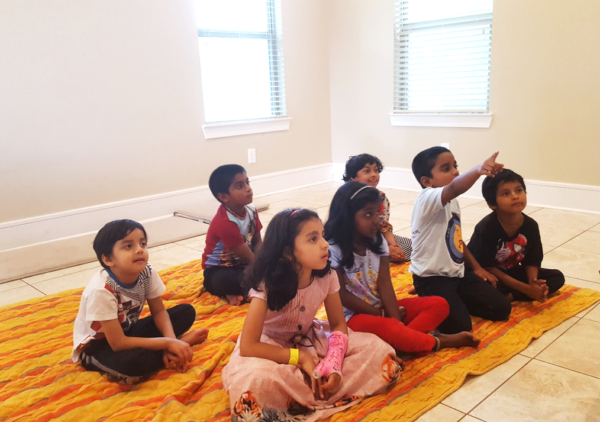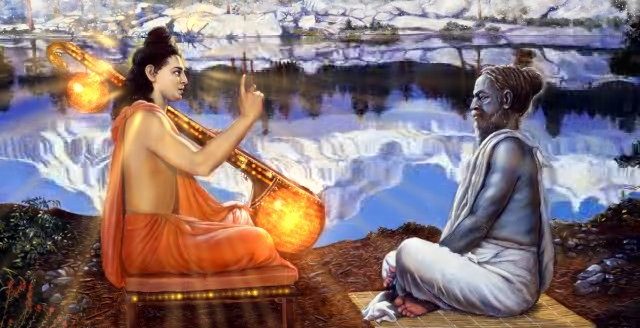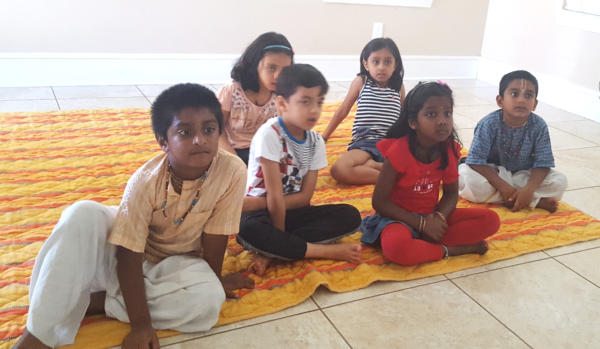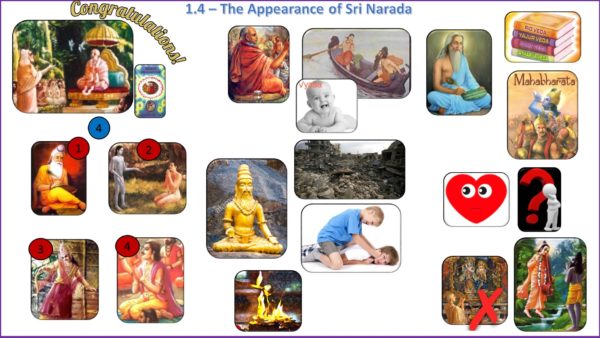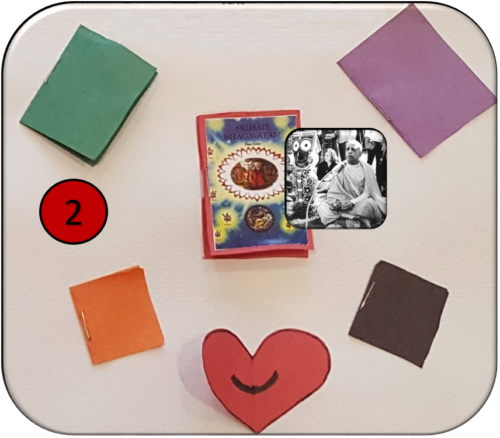The taste I received of Srimad Bhagavatam during our Bhakti-Vaibhava studies under HG Radha Krishna dasa (TKG) from Houston was kindling my desire to share the Srimad Bhagavatam with our twin boys somehow. For few years I kept this desire in the core of my heart not knowing how to teach the boys in a formal way given they were very young (< 5 years).
Finally when the boys turned five, Prahlad maharaja’s instruction given in SB 7.6.1, kept coming to my mind often:
śrī-prahrāda uvāca
kaumāra ācaret prājño
dharmān bhāgavatān iha
durlabham mānuṣam janma
tad apy adhruvam arthadam
Translation: Prahlāda Mahārāja said: One who is sufficiently intelligent should use the human form of body from the very beginning of life—in other words, from the tender age of childhood—to practice the activities of devotional service, giving up all other engagements. The human body is most rarely achieved, and although temporary like other bodies, it is meaningful because in human life one can perform devotional service. Even a slight amount of sincere devotional service can give one complete perfection.
Even though I dint have a clue how exactly to go about teaching them, I felt inspired to somehow start and depend on Krsna. We gathered bunch of neighborhood devotee children around the same age (5-6 yrs) and started having a weekly “Kids Bhagavatam” session.
During the process, Krsna inspired me to write short poems encapsulating the philosophical concepts. This was the turning point. These poems not only helped the kids retain the concepts but also inspired them to inquire further into the subject matter. For example, after discussing the concept of nitya-baddha and nitya-mukta, my younger son Maharathi one day asked, “Amma, what does it mean to be bound”?
These regular Bhagavatam sessions, are also helping them to assimilate the essence of our philosophy into their lives. For instance, while dressing my older son, Nrsimha to school, one day he started saying, “When I go to Krsna..”. Puzzled, I asked, “What do you mean you go to Krsna”? He said, “When I clean my heart before dying, I will go back to Krsna and then …”. Other day while all of us were going to the Dussehra festival, another kid, Ovi, six year old, who attends the sessions was riding along with us. She asked, “Mathaji, you were teaching us the difference between materialistic men and pure devotees, and now we are also going to enjoy, so is this wrong”. I clarified to her how enjoyment with Krsna in the center is not harmful to us.
By Krsna’s mercy, now it is very clear how to teach Srimad Bhagavatam in a systematic way to small kids of age 5 – 6 yrs.
In our weekly sessions, we start with the visual summary of the chapter covered thus far, while kids sing the related poems they learnt. Then we cover the specific set of verses for that week in depth with illustrations, learn related poems, discuss practical examples and have interactive discussions. We then discuss a pastime from our scriptures that exemplifies the concepts discussed and we end with a mock drama enacting the pastime. For example when we discussed SB 1.1.15, where the sages mention that pure devotees can purify one very quickly, we discussed how Narada muni received mercy from the Bhakti-vedantas and became perfect and enacted the drama.
Now I can see that all the kids have developed genuine taste for the subject matter and look forward for the sessions as they have “Krsna conscious fun” with their friends.
To share with devotees worldwide, we have been compiling summary videos of Srimad Bhagavatam chapters, which you can view below. These video helps other kids of similar age to learn the chapter summaries as well as the poems. It will also be useful for older children and adults who want to teach the same to their kids.
We pray these inspire some of you to try this teaching methodology with your kids at home/Sunday school etc. We seek your blessings to continue this journey of learning Srimad Bhagavatam.
Note: You do not need to wait until your child turns five to use these resources. As younger children primarily learn via hearing, we can play audio of the summary/continuously play the poems, and without extra endeavor, they will learn and develop taste for the amala purana – Srimad Bhagavatam.
Your servant,
Syamala dasi (IDS) (Oct 24th, 2018)
KIDS BHAGAVATAM ARTICLES
Discussing SB 1.7 in Kids Bhagavatam
While contemplating our impending move to India, I was debating whether to start a new chapter. I asked the kids to see what their reaction is. Maharathi very eagerly said, “This is the chapter about Pandavas I want to hear you cannot stop”. I also noticed he is developing a genuine desire to chant chant the Holy Names. The other day he was saying, my only business is to chant. I added, “And to tell others to chant”.
To serve their eagerness, last Saturday we started “SB 1.7 – Son of Drona
Nārada muni’s glories
At the beginning of Srimad Bhagavatam Canto 1, Chapter6, Srila Vyasadeva asks three questions to Nārada muni about his previous life. The last one of which is, “How do you remember your previous life from the previous day of Brahma (4.32 billion years ago)”. Nārada muni replies to this question from 1.6.26 onwards.
After the Lord stopped speaking, Nārada muni (in his previous body) led rest of his life chanting the holy name and fame of the Lord and traveled all over the earth fully satisfied, humble and unenvious. In due course of time as he was fully Krsna conscious, when Nārada muni met
Lord’s dealings with Narada Muni
In his previous life, when Nārada muni was just a 5-year-old boy, his mother, his only guardian passed away due to a snakebite. He took it as causeless mercy of the Lord and started walking to the north. On the way, he saw many metropolises, villages, animal farms, and flower gardens. Nevertheless, he was not attracted by any of them. Feeling very tired and thirsty he finally reached a lakeshore, having refreshed himself by drinking water he sat down under a Banyan tree to meditate on the Supreme Lord as instructed by the Bhakti-Vedantas (sages).
He advances in his devotion very quickly to come
Lord’s Transcendental form
In our Kids Bhagavatam session today, we discussed SB 1.6.11-19. Kids traveled along with Narada to towns, metropolises, villages, flower gardens. To understand the meaning of “bhava” stage Narada muni was in, they learnt “Nine stages of Bhakti” through a short sing able/poem.
Narada though elated upon seeing the Lord’s form in the first attempt, becomes despondent when the form is lost and frustrated when he couldn’t get to see it again.
Kids learnt the following poem, which encapsulates the essence of 1.6.18-19 verses and purports.
Title: Lord’s transcendental form
So many forms, I have seen, in this world, but none of them gave me satisfaction
O my
Discussion on “Karma” with 6 year olds
After hearing about the recent incident of how a local devotee was gun shot in his convenient store, our curious 6-year-old kids started asking following questions:
Nrsimha-Krsna dasa: When Krsna’s devotee is good, why somebody killed him like that.
Father: Everybody has to face reactions to bad things they did previously, that is how material nature works. See for example, sometimes you pinch Maharathi and remember that day nobody did anything, you were playing and you hit against the pillar, got a cut on the head and it started bleeding. That is how reactions come. Everybody has to face his or her reactions. There is
SB 1.4 Summary Video
Here is the short summary of SB 1.4 – The Appearance of Śrī Nārada:
- Verses 1-13: After hearing the answers to the six questions asked by the sages in Chapter1, Saunaka Rsi asks four new questions about the history of Srimad Bhagavatam.
- Verses 14-25: Suta Gosvāmī starts answering the question about when, where, how and why did Srila Vyasadeva write Srimad Bhagavatam. After summarizing Vyasa’s birth, he describes how Vyasadeva foresaw anomalies of the age of kali and decided to divide the Vedas into four for the welfare of common people. He even wrote the Mahabharata.
- Verses 26-31: In spite of engaging


